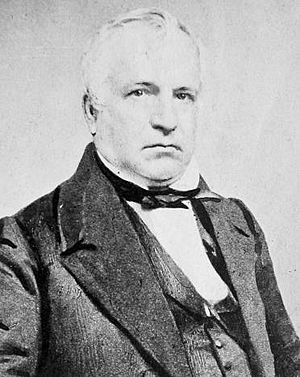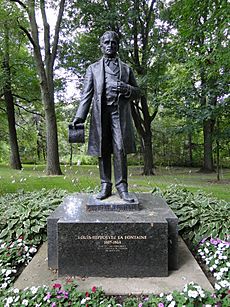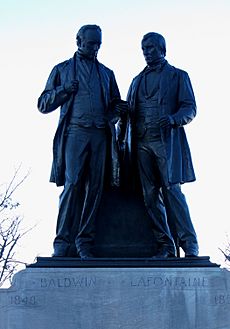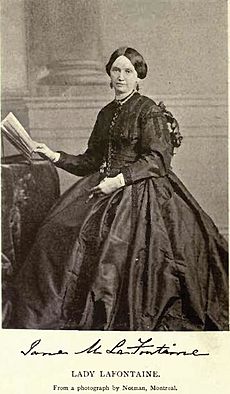Louis-Hippolyte Lafontaine facts for kids
Quick facts for kids
Sir Louis-Hippolyte La Fontaine
|
|
|---|---|

Sir Louis-Hippolyte La Fontaine, Bt
|
|
| Joint Premier of Province of Canada, for Canada East | |
| In office September 26, 1842 – November 27, 1843 |
|
| Preceded by | Samuel Harrison |
| Succeeded by | Sir Dominick Daly |
| In office March 11, 1848 – October 28, 1851 |
|
| Preceded by | Denis-Benjamin Papineau (deputy) Dominick Daly (as premier) |
| Succeeded by | Augustin-Norbert Morin |
| Personal details | |
| Born |
Louis Hippolyte Ménard
October 10, 1807 Boucherville, Lower Canada |
| Died | February 26, 1864 (aged 56) Montreal, Province of Canada |
| Political party | Parti patriote, Reform |
| Spouses | Adèle Berthelot, Jane Élisabeth Geneviève Morrison |
| Profession | Lawyer |
| Signature | |
Sir Louis-Hippolyte La Fontaine (born October 4, 1807 – died February 26, 1864) was a very important Canadian politician. He became the first Premier of the United Province of Canada. He also led the first "responsible government" in Canada. This meant that the government had to answer to the elected representatives, not just the Governor.
La Fontaine was born in Boucherville, which was then called Lower Canada. He was a lawyer and a statesman. He was first elected to the government in 1830. He supported Louis-Joseph Papineau and was part of the Parti patriote. After the Rebellions of 1837 against British rule, he worked for political changes under the new Union of 1841.
Under this new Union of the two Canadas, he teamed up with Robert Baldwin. Together, they formed a group of liberal reformers from both Upper and Lower Canada. They formed a government in 1842 but resigned in 1843. In 1848, the Governor-General, Lord Elgin, asked La Fontaine to form the first government under the new idea of responsible government. The La Fontaine-Baldwin government, which started on March 11, fought to bring back French as an official language. It had been removed when the Union Act was passed. They also fought for the principles of responsible government and the "double-majority" rule for passing laws.
While Baldwin was making changes in Canada West (Upper Canada), La Fontaine passed laws to end the seigneurial system. This was an old land ownership system. He also granted forgiveness to the leaders of the rebellions in Lower Canada who had been sent away. This law was passed, but some people in Canada East, called loyalists, did not like it. They protested violently and burned down the Parliament building in Montreal.
La Fontaine left politics in 1851. However, he was appointed Chief Justice of Canada East in 1853. In 1854, Queen Victoria made him a baronet. A year later, in 1855, Pope Pius IX made him a knight commander in the Order of St. Sylvester. His last name is sometimes written as one word, "Lafontaine," and that's how he often signed it.
Working for Change
In Canada East, it was hard for La Fontaine to get elected. Some people tried to stop him by changing voting districts (called gerrymandering) and using violence. To help La Fontaine get a seat in the government, Robert Baldwin suggested that David Willson, a leader of a group called the Children of Peace, nominate La Fontaine for a seat in 4th York.
Baldwin also insisted that the Governor, Sydenham, include La Fontaine in the government's Executive Council. If not, Baldwin would resign from his own position. This partnership allowed La Fontaine to get a seat in the assembly in 1841. It also helped Baldwin win a special election in 1843.
The Children of Peace and Elections
During the 1840s, David Willson and the Children of Peace continued to support the Reform Party. Willson managed campaigns for both Robert Baldwin and La Fontaine. These two men are known as the "Fathers of Responsible Government" and were the first elected premiers of the province.
The Children of Peace helped elect Louis La Fontaine, a lawyer from Montreal, as their representative in Upper Canada. Willson believed this was a chance to show respect to the French-speaking people of the Lower Province. This showed a clear Canadian identity that went beyond differences in language and religion. This idea of Canadian citizenship was successful, as La Fontaine was elected in the 4th Riding of York. Later, they also elected Baldwin in their area.
The Children of Peace's band was often seen at Baldwin's campaign events. In 1844, they held a rally for Baldwin at their Sharon Temple. More than 3,000 people attended. This event helped to stop violence during elections.
On September 3, 1841, the Children of Peace held a rally for Baldwin and La Fontaine at their Temple. They were happy to show their respect to the people of the Lower Province. Despite threats of violence, La Fontaine was elected as the representative for 4th York.
Forming the First Responsible Government
Before La Fontaine could take his seat, Governor Sydenham died. His replacement, Sir Charles Bagot, could not form a government with both reformers and other parties. So, he had to include the "Canadien party" led by La Fontaine.
La Fontaine refused to join the Executive Council unless Baldwin was also included. Bagot finally agreed in September 1842. When Bagot became very ill, Baldwin and La Fontaine became the first true premiers of the Province of Canada.
To take office as ministers, both men had to run for re-election. La Fontaine was easily re-elected in 4th York. However, Baldwin lost his seat in Hastings because of violence. This made the bond between the two men even stronger. La Fontaine arranged for Baldwin to run in Rimouski, Canada East. This showed the true union of the Canadas they wanted. La Fontaine overcame language differences to win a seat in English Canada, and Baldwin won his seat in French Canada.
His Family Life
Louis-Hippolyte La Fontaine first married Adèle Berthelot on July 9, 1831. They did not have any children. His original family name was Ménard.
Later, on January 30, 1861, he married Jane Élisabeth Geneviève Morrison in Montreal. She was a widow. This second marriage gave him two sons, but sadly, both died when they were very young. The older son, Louis-Hippolyte, was born in 1862 and inherited his father's title at 18 months old in 1864, but he died in 1867. The family lived on Saint Denis Street in Montreal.
Remembering La Fontaine
Many places and monuments honor Louis-Hippolyte La Fontaine's memory.
La Fontaine Park in Montreal
The city of Montreal named Louis-Hippolyte La Fontaine Park to remember him. The unveiling of the La Fontaine Monument in this park was a big event. It honored a great man who is seen as the father of responsible government in Canada.
A book published in 1930, called Hommage à LaFontaine, collected letters and speeches about the monument's unveiling. People clearly saw him as a great man. The mayor, C. Houde, explained how the monument was put up to remember "Sir Louis Hippolyte Lafontaine, father of responsible government in Canada."
Monument in Boucherville

La Fontaine was born in Boucherville. A monument was also unveiled there after his death. A special plaque was placed on his birth home. Dr. Eudore Dubeau, a local doctor, said that about ten thousand people attended the unveiling. The bronze plaque on his home says he was the "Father of responsible government" and "Defender of the French language."
La Fontaine refused to speak English in the Assembly. He fought for people to be able to speak their mother tongue. He believed French Canadians had the right to speak French. It wasn't that he couldn't speak English; he just strongly supported the right to use one's own language.
The Louis-Hippolyte-La Fontaine Bridge-Tunnel
The Louis-Hippolyte Lafontaine Bridge-Tunnel was named after him to keep his memory alive for future generations. Construction of this tunnel began in 1963.
Louis-Hippolyte Ménard Hospital
The Louis-Hippolyte-La Fontaine Hospital opened in 1873. It was, and still is, a psychiatric hospital. Its name was changed to honor La Fontaine, though the exact reason for choosing his name is not fully known.
Baldwin and La Fontaine Monument on Parliament Hill

A statue of La Fontaine and Baldwin stands on Parliament Hill in Ottawa. It was created by Walter Seymour Allward, who is famous for designing the Vimy Ridge Memorial in France.
The La Fontaine-Baldwin government was very powerful between 1849 and 1850. During this time, La Fontaine worked to abolish the old seigneurial system. He also wanted to make sure that landowners were fairly paid for their losses. Baldwin and La Fontaine worked hard to create unity in the Canadian government and build a truly responsible government. You can learn more about them in a Canadian Historical Minute video called "Baldwin and La Fontaine" online.
Awaiting Historical Designation
The house where Louis-Hippolyte La Fontaine lived as a politician in Montreal is still standing today. It is located at 1395 Overdale. However, the City of Montreal has not yet made it a historical site.
Senator Serge Joyal discovered in July 1987 that this was once La Fontaine's home. During the protests over the Rebellion Losses Bill, when Parliament was burned, this house was also attacked by rioters. Since its rediscovery in 1987, the house has been left to decay. Heritage Montreal has been trying for many years to get the city to help save and renovate the house. They hope it can become a museum to explore the history of responsible government in Canada.
See also
 In Spanish: Louis-Hippolyte Lafontaine para niños
In Spanish: Louis-Hippolyte Lafontaine para niños
- Canadian peers and baronets
- LaFontaine-Baldwin Symposium
- Louis-Joseph Papineau
- Lower Canada Rebellion
- Timeline of Quebec history





